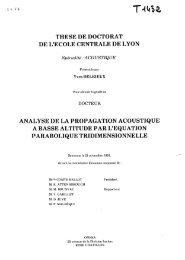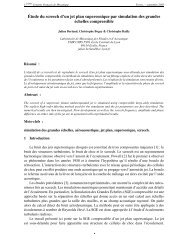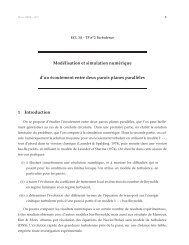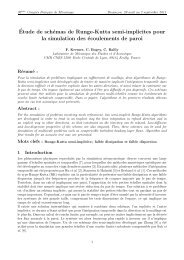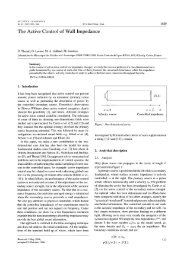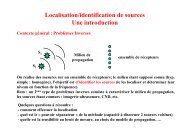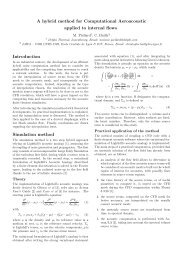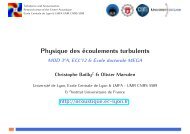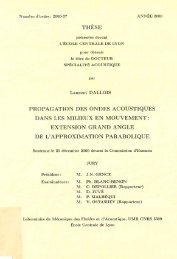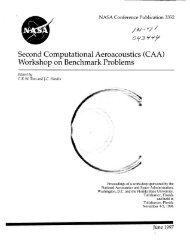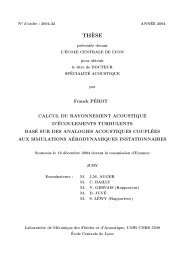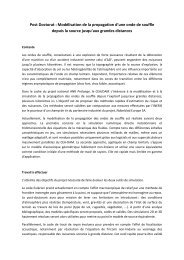On the radiated noise computed by large-eddy simulation
On the radiated noise computed by large-eddy simulation
On the radiated noise computed by large-eddy simulation
You also want an ePaper? Increase the reach of your titles
YUMPU automatically turns print PDFs into web optimized ePapers that Google loves.
Phys. Fluids, Vol. 13, No. 2, February 2001 <strong>On</strong> <strong>the</strong> <strong>radiated</strong> <strong>noise</strong> <strong>computed</strong> <strong>by</strong> <strong>large</strong>-<strong>eddy</strong> <strong>simulation</strong><br />
unresolved- and subgrid-scales contribution to <strong>the</strong> <strong>radiated</strong><br />
<strong>noise</strong> itself when Lighthill’s analogy and LES are used toge<strong>the</strong>r<br />
for <strong>large</strong>r Reynolds number turbulent flows on <strong>the</strong><br />
ground of a priori and a posteriori tests. The case of <strong>the</strong><br />
sound <strong>radiated</strong> <strong>by</strong> a volume of isotropic turbulence is retained<br />
as a test case for <strong>the</strong> present study. This is an academic<br />
case, which is one of <strong>the</strong> very few examples of turbulent<br />
flow whose equivalent acoustic source has well defined<br />
properties. It appears consequently as a first step toward <strong>the</strong><br />
derivation of fully general model. This problem has been<br />
addressed <strong>by</strong> many authors, both from a <strong>the</strong>oretical 14,19 and a<br />
numerical 10,20 point of view. Never<strong>the</strong>less, even for this very<br />
simple turbulent flow, <strong>the</strong> authors are not aware of any published<br />
a posteriori tests for subgrid models for <strong>the</strong> <strong>noise</strong><br />
source, <strong>the</strong> previous studies being devoted to a priori analysis.<br />
Considering that <strong>the</strong> modeling process for <strong>the</strong> subgrid<br />
<strong>noise</strong> source should start with simple flows, which are well<br />
controlled from a <strong>the</strong>oretical and numerical point of view,<br />
isotropic turbulence appears as an mandatory first step. But,<br />
as for <strong>the</strong> modeling of usual subgrid terms, recall that <strong>the</strong><br />
extension to more complex flows could be required to complicate<br />
<strong>the</strong> models. This point will be addressed in future<br />
works.<br />
The ma<strong>the</strong>matical formulation concerning Lighthill’s<br />
equation is first presented in Sec. II. Section III is devoted to<br />
<strong>the</strong> description of <strong>the</strong> numerical method and <strong>the</strong> implementation<br />
of acoustic calculations for <strong>the</strong> study. Numerical results<br />
obtained from a priori tests i.e., filtered DNS and<br />
concerning both evaluation and modeling of <strong>the</strong> subgrid<br />
scale effects are detailed in Sec. IV. In order to assess conclusions<br />
given <strong>by</strong> <strong>the</strong> filtered DNS, a posteriori tests described<br />
in Sec. V have been carried out. Conclusions are<br />
presented in Sec. VI.<br />
II. MATHEMATICAL FORMULATION<br />
A. Governing equations<br />
Lighthill’s analogy 12,13 is a method to compute <strong>the</strong> <strong>radiated</strong><br />
acoustic field from a finite region of turbulent flow. This<br />
analogy is based on a combination of compressible Navier–<br />
Stokes equations which leads to an inhomogeneous wave<br />
equation for <strong>the</strong> density<br />
2 t 2 c 2<br />
2<br />
0 <br />
y iy i<br />
2<br />
T<br />
y<br />
ij, 1<br />
iy j<br />
where c0 is <strong>the</strong> constant speed of sound in <strong>the</strong> ambient medium,<br />
which is supposed to be at rest, and <strong>the</strong> Lighthill tensor<br />
Tij is defined as follows:<br />
T iju iu jpc 0 2 ij ij. 2<br />
For high Reynolds numbers <strong>the</strong> viscous stress tensor ij in<br />
Lighthill’s tensor expression can be neglected. The quantity<br />
2 21<br />
(pc 0) is responsible for <strong>the</strong>rmoacoustics effects and<br />
will be neglected for <strong>the</strong> class flow that have been considered<br />
in this paper. Under <strong>the</strong>se assumptions, <strong>the</strong> Lighthill tensor<br />
simplifies to<br />
Tiju iu j . 3<br />
The solution of <strong>the</strong> Lighthill equation leads to a representation<br />
of <strong>the</strong> <strong>radiated</strong> acoustic field. <strong>On</strong>ce <strong>the</strong> acoustic source<br />
term, which is zero outside <strong>the</strong> flow region, has been <strong>computed</strong><br />
<strong>by</strong> solving <strong>the</strong> Navier–Stokes equations to compute<br />
variables and u i , <strong>the</strong> sound field generated <strong>by</strong> <strong>the</strong> turbulent<br />
motion is uniquely defined. This equation has an exact solution<br />
only for an homogeneous medium at rest, which can be<br />
obtained using <strong>the</strong> Green function. For high Reynolds number<br />
flow, a complete knowledge of <strong>the</strong> source term requires a<br />
high resolution of <strong>the</strong> flow field and <strong>the</strong>n an important computational<br />
cost. A direct numerical <strong>simulation</strong> DNS may<br />
only be applied on simple configurations 22 and is far from<br />
addressing range of Reynolds number that have to be dealt<br />
with in practice.<br />
B. Extension to LES<br />
When a <strong>large</strong>-<strong>eddy</strong> <strong>simulation</strong> is performed to obtain<br />
aerodynamic fluctuations, Lighthill’s equation should be derived<br />
from <strong>the</strong> filtered Navier–Stokes equations. This formalism<br />
has been presented <strong>by</strong> Seror et al. 17 for <strong>the</strong> compressible<br />
subsonic case. Since we are dealing with very low<br />
Mach number turbulent flows, <strong>the</strong> present <strong>simulation</strong>s have<br />
been performed using <strong>the</strong> incompressible Navier–Stokes<br />
equations. As expressed in Crow’s paper 23 <strong>the</strong> inconsistent<br />
incompressible approximation to Lighthill’s source term is<br />
justifiable for low Mach number turbulent flow. More recently,<br />
Ristorcelli 24 has shown that <strong>the</strong> associated error term<br />
scales as <strong>the</strong> square of <strong>the</strong> Mach number. This approximation<br />
is <strong>the</strong>n appropriate to compute flows which are under consideration<br />
in <strong>the</strong> present work.<br />
In <strong>large</strong>-<strong>eddy</strong> <strong>simulation</strong> of turbulent flows, any quantity<br />
F in <strong>the</strong> flow domain V can be split into a resolved or filtered<br />
part F ¯ and an unresolved or subgrid part f through <strong>the</strong> application<br />
of a low-pass convolution filter:<br />
with<br />
FF ¯ f , 4<br />
F¯ y GyFd, 5<br />
V<br />
where G is <strong>the</strong> spatial kernel filter and /k c <strong>the</strong> characteristic<br />
cutoff length scale. The cutoff wave number k c<br />
defines <strong>the</strong> limit between <strong>the</strong> low-frequency components resolved<br />
in <strong>the</strong> <strong>simulation</strong> and <strong>the</strong> remaining high-frequency<br />
components which are modeled. The kernel G is currently<br />
represented <strong>by</strong> a sharp cutoff filter, a Gaussian filter or tophat<br />
filter for analytical development. This function is assumed<br />
to fulfill <strong>the</strong> three following constraints: constant<br />
preservation, linearity and commutativity with derivatives. A<br />
filtered Lighthill equation can <strong>the</strong>n be obtained in <strong>the</strong> following<br />
two ways: <strong>by</strong> operating <strong>the</strong> combination between <strong>the</strong><br />
filtered continuity equation and filtered momentum equation<br />
used in LES or <strong>by</strong> filtering <strong>the</strong> Lighthill equation 1. Both<br />
methods lead to <strong>the</strong> equation<br />
2<br />
t 2 ¯c 0 2 2<br />
y iy i<br />
477<br />
¯ 2<br />
T¯<br />
y<br />
ij. 6<br />
iy j<br />
Downloaded 17 Mar 2003 to 156.18.39.49. Redistribution subject to AIP license or copyright, see http://ojps.aip.org/phf/phfcr.jsp



